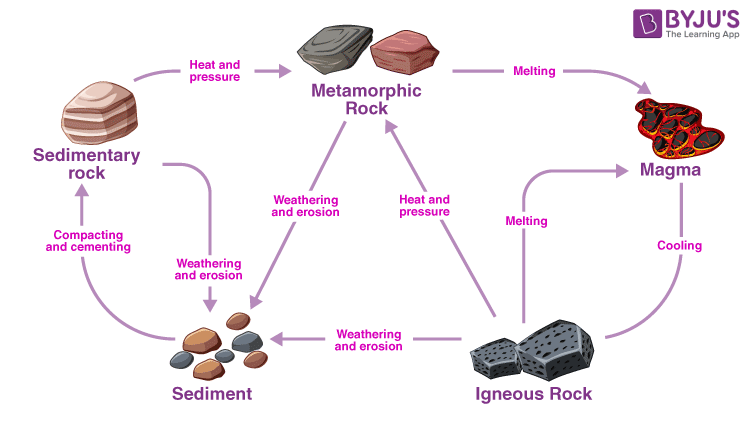We see rocks in our surroundings, from different shapes to sizes. Rocks never remain the same, and they are always changing with time. The Rock cycle is a basic concept in geology that describes the time-consuming transitions through geologic time.
Rocks are constantly being recycled and going through several processes of chemical and physical changes. There are three main rock types:
- Sedimentary
- Metamorphic
- Igneous
The diagram below shows that rocks are altered or destroyed when it is forced out of its equilibrium conditions. This cycle of rock formation and wearing out is constantly recycled the earth’s minerals. The rock cycle is nothing but a process by which rocks of one type with certain characteristics change into rocks of another kind.

Rock Cycle: Transition to Igneous
When rocks are pushed deep under the earth’s surface, they may melt into magma. If the conditions no longer exist for the magma to stay in its liquid state, it will solidify into an igneous rock.
Rock Cycle: Transition to Metamorphic
The rock exposed to high temperatures and pressures can be changed physically or chemically to form a different rock, called metamorphic.
Read More: Rock Types
For more information on the formation of metamorphic rocks, watch the below video

Rock Cycle: Transition to Sedimentary
Rocks exposed to the atmosphere are very unstable and subject to the processes of weathering and erosion. This process breaks the original rock down into smaller fragments and carries away dissolved materials. Sedimentary rocks form from deposits that accumulate on the Earth’s surface.
Read More: Weathering
Frequently Asked Questions – FAQs
What is a rock?
What are the main three types of rocks?
What is a rock cycle?
Explain the creation of igneous rock.
How metamorphic rocks are formed?
The video about the types of rock and rock formation

Stay tuned with BYJU’S for more such interesting articles. Also, register to “BYJU’S – The Learning App” for loads of interactive, engaging Physics-related videos and unlimited academic assistance.

Comments